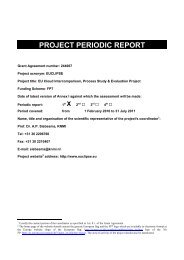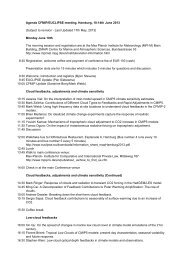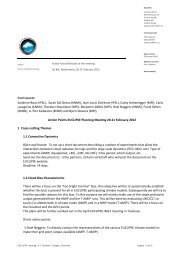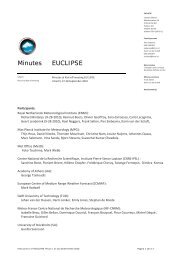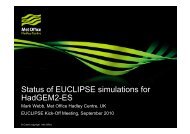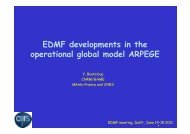The Madden–Julian Oscillation in ECHAM6 and the ... - euclipse
The Madden–Julian Oscillation in ECHAM6 and the ... - euclipse
The Madden–Julian Oscillation in ECHAM6 and the ... - euclipse
Create successful ePaper yourself
Turn your PDF publications into a flip-book with our unique Google optimized e-Paper software.
3252 JOURNAL OF CLIMATE VOLUME 26<br />
FIG. 6. Scatter of (a) east/west ratios of <strong>the</strong> spectra of precipitation Rpre <strong>and</strong> OLR ROLR, <strong>and</strong> (b) fractional expla<strong>in</strong>ed<br />
variances of OLR FOLR <strong>and</strong> precipitation Fpre of multivariate EOF derived from <strong>the</strong> zonal w<strong>in</strong>ds <strong>in</strong> 850 <strong>and</strong><br />
200 hPa, <strong>and</strong> OLR <strong>and</strong> precipitation, respectively. Filled symbols <strong>in</strong>dicate <strong>the</strong> mean of experiment group; open<br />
<strong>in</strong>dicate s<strong>in</strong>gle simulations.<br />
ECHAM5 or <strong>ECHAM6</strong>, hence <strong>the</strong> differences may be<br />
real.<br />
Our analysis suggests that <strong>the</strong>re is a basis for be<strong>in</strong>g<br />
cautious when <strong>in</strong>terpret<strong>in</strong>g <strong>the</strong> model’s OLR signal as<br />
representative of precipitation but that, for <strong>the</strong> ECHAM5<br />
<strong>and</strong> <strong>ECHAM6</strong> experiments on which <strong>the</strong> bulk of our<br />
analysis is based, this is probably feasible.<br />
c. Metric for <strong>the</strong> MJO<br />
<strong>The</strong> jo<strong>in</strong>t efforts of <strong>the</strong> community (e.g., Waliser et al.<br />
2003, 2009; Zhang et al. 2006; Kim et al. 2009, 2011) to<br />
collapse a diverse set of diagnostics <strong>in</strong>to a relatively<br />
small number of quantities that can be used to measure<br />
<strong>the</strong> skill with which a model represents <strong>the</strong> MJO made<br />
much of <strong>the</strong> present analysis possible. <strong>The</strong> question<br />
arises as to whe<strong>the</strong>r <strong>the</strong>se metrics can be fur<strong>the</strong>r reduced,<br />
at least for <strong>the</strong> purpose of evaluat<strong>in</strong>g our simulations.<br />
In effect this raises <strong>the</strong> question of relationships<br />
between <strong>the</strong> various quantities identified <strong>in</strong> <strong>the</strong> MJO<br />
diagnostics we have explored. To <strong>the</strong> extent that a s<strong>in</strong>gle<br />
quantity provides a first <strong>in</strong>dication of <strong>the</strong> MJO representation<br />
by <strong>ECHAM6</strong>, which as far as climate models is<br />
concerned has a good representation of <strong>the</strong> MJO, it<br />
might also prove useful for <strong>the</strong> analysis of o<strong>the</strong>r models.<br />
For <strong>the</strong> ensemble of experiments performed by<br />
ECHAM,onequantitycanoftenbeagoodproxyfor<br />
ano<strong>the</strong>r. Especially <strong>the</strong> R values of <strong>the</strong> different variables<br />
are correlated (e.g., R u850 <strong>and</strong> R u200; Fig.7a).<br />
On <strong>the</strong> o<strong>the</strong>r h<strong>and</strong>, <strong>the</strong> expla<strong>in</strong>ed variances <strong>in</strong> different<br />
quantities are less well correlated; <strong>in</strong> particular, F OLR<br />
(or F pre) shows little relation to <strong>the</strong> o<strong>the</strong>r F quantities<br />
(e.g., F u200; Fig. 7b). <strong>The</strong>refore, <strong>in</strong> evaluat<strong>in</strong>g <strong>the</strong> present<br />
simulations, at least two quantities need to be considered:<br />
1) <strong>the</strong> eastward propagation <strong>and</strong> 2) <strong>the</strong> strength<br />
of <strong>the</strong> precipitation signal. Because <strong>the</strong> R of OLR (or<br />
precipitation) <strong>and</strong> <strong>the</strong> zonal w<strong>in</strong>ds are reasonably well<br />
correlated, one of <strong>the</strong>se quantities (or <strong>the</strong>ir mean) could be<br />
sufficient to describe <strong>the</strong> eastward propagation. We propose<br />
to utilize <strong>the</strong> mean of <strong>the</strong> three numbers R mean because<br />
it is likely a more robust representation of <strong>the</strong><br />
eastward propagation strength of <strong>the</strong> convective envelope.<br />
Because <strong>the</strong> strength of <strong>the</strong> convective signature FOLR<br />
is barely correlated with <strong>the</strong> o<strong>the</strong>r quantities it merits<br />
separate consideration. Moreover, F OLR is a crucial<br />
quantity because it is considerably underestimated, even<br />
<strong>in</strong> our best simulations. <strong>The</strong>refore, <strong>the</strong> second MJO<br />
characteristic that we explicitly account for <strong>in</strong> our MJO<br />
score is F OLR. This motivates <strong>the</strong> <strong>in</strong>troduction of <strong>the</strong><br />
metric MJO sc as a useful measure of <strong>the</strong> MJO:<br />
MJOsc 5<br />
qffiffiffiffiffiffiffiffiffiffiffiffiffiffiffiffiffiffiffiffiffiffiffiffiffiffiffiffiffiffiffiffiffiffiffiffiffiffiffiffiffiffiffiffiffiffiffiffiffiffiffiffiffiffiffiffiffiffiffiffiffiffiffiffi<br />
[max(1, Rmean ) 2 1] FOLR /100.<br />
(1)<br />
In Eq. (1), max(1, R mean) 2 1 assures that MJO sc is set to<br />
zero if Rmean is less than one; that is, <strong>in</strong> <strong>the</strong> absence of<br />
eastward propagation dom<strong>in</strong>at<strong>in</strong>g we do not f<strong>in</strong>d it



